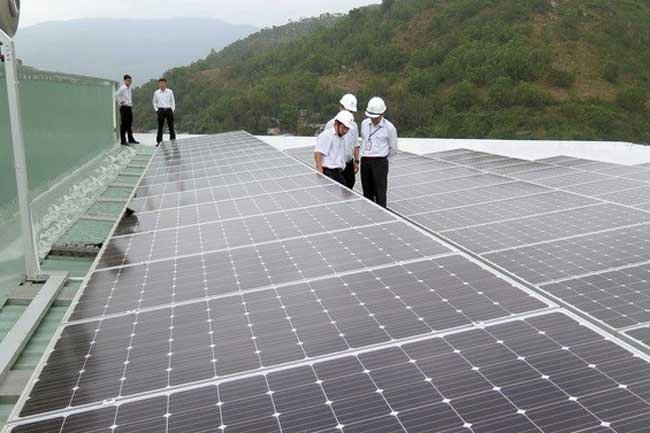Several investors have announced plans to develop solar power plants in Vietnam as the prime minister’s decision providing incentives in terms of power price will expire in June next year.
Solar panels are seen on the roof of the building of Binh Dinh Power Company. Investors have announced multiple solar power projects
According to the Ministry of Industry and Trade, as of August this year, 121 solar power projects with a combined designed capacity of 6,100 megawatts (MW) had been added to the national and provincial power development plans, Tuoi Tre Online newspaper reported.
Of these, Vietnam Electricity Group (EVN) agreed to purchase the output from 25 projects.
The government of the southern province of Tay Ninh has approved a number of solar power projects as well, including Dau Tieng plants 1, 2 and 3 with a combined capacity of 500 MW. Dau Tieng Tay Ninh Energy JSC is the investor behind these projects, which require a total investment of VND12.5 trillion (US$536.7 million).
Other solar power projects are also being developed in the Dau Tieng Lake area, including Tri Viet 1 and Bach Khoa A Chau 1.
These projects are expected to be completed prior to June next year, turning Tay Ninh into a large renewable energy generation center in Vietnam.
Regarding the progress of these projects, Tran Quang Hung, deputy director of Dau Tieng-Phuoc Hoa Irrigation Co., Ltd, said that his company had coordinated with the local authorities to hand over land to the projects.
According to Bui Van Thinh, chairman and general director of Thuan Binh Wind Power JSC, besides wind power, the company has ventured into the solar power sector with a 150-MW plant in Tuy Phong District, Binh Thuan Province.
Also, Bamboo Capital Group (BCG) has invested US$200 million in three solar power projects with a combined capacity of 200 MW in the Mekong Delta province of Long An. The firm is also executing other projects in Quang Nam Province and HCMC.
BCG chairman Nguyen Ho Nam said that the group expected to supply two gigawatts of electricity to meet the domestic demand.
The current situation reportedly arose from a decision of Prime Minister Nguyen Xuan Phuc, which offers a slew of supporting mechanisms for the development of solar power projects, including a hike in the solar power price to VND2,086, or 9.35 U.S. cents, per kilowatt hour (kWh), excluding value-added tax.
After June 30 next year, the price may drop, according to an expert from the Ministry of Industry and Trade.
The development of renewable energy could help reduce environmental pollution, on the one hand, but may put pressure on the infrastructure of the national grid, the representative added.
Tran Viet Ngai, chairman of the Vietnam Energy Association, said that while hydropower potential has been fully tapped, the development of solar and wind power is an indispensable trend across the world. In Vietnam, the Government has focused on developing solar power since 2007, he said.
In related news, more and more households have installed solar panels on their roofs to generate electricity. These households’ solar power systems have been connected to the national grid.
According to Bach Khoa Investment and Development of Solar Energy Corporation, which has cooperated with HCMC Power Corporation to distribute and install solar panels, nearly 200 households have had solar power systems installed on the roofs of their houses since July.
In the past, it took some three years to have 300 solar power systems installed.
Some 1.77 million kWh of electricity from local households’ solar power systems was added to the national grid by late July.
Nguyen Hoang Gia, general director of HCMC Energy Solutions JSC, said the number of clients commissioning his company has increased sharply since early this year, including 30 households, three State management agencies and one corporation.
According to the Ministry of Industry and Trade, households’ investment in solar panels will help generate electricity for their use, reducing pressure on the national grid.
The ministry has teamed up with the Ministry of Finance and EVN to ask for the prime minister’s support in removing obstacles to the development of a solar power system.
Gia Lai inaugurates mega-solar power plant
TTC Group and Gia Lai Electricity JSC, on December 1, put into operation the Krong Pa solar power plant, with an investment of VND1.4 trillion, in the Central Highlands province of Gia Lai, news site Vietnamplus reported.
The plant, which covers more than 70 hectares in Chu Gu Commune, Krong Pa District, has a capacity of 49 MW. It was built in March with over 209,000 solar panels.
The plant is expected to annually add 103 million kWh of electricity to the national grid, serving some 47,000 local households. It will also help reduce carbon dioxide emissions by some 29,000 tons per year.
Krong Pa, with its average temperature of over 25 degrees Celsius and six hours of sunshine per day, or 2,500 hours per year, is ideal for attracting solar power projects to the district.
The development of renewable energy will help exploit the land funds, create multiple jobs for the local people and improve the living standards in Krong Pa, one of the poorest districts in Gia Lai.
Speaking at the inauguration ceremony of the Krong Pa solar power plant, Gia Lai Chairman Vo Ngoc Thanh spoke highly of the efforts of TTC Group in putting the solar power plant into operation on schedule and asked the group to continue investing in other projects to boost the province’s socioeconomic development.
On the occasion, Gia Lai Electricity JSC presented 10 houses, worth VND500 million, to disadvantaged households in Krong Pa District.














